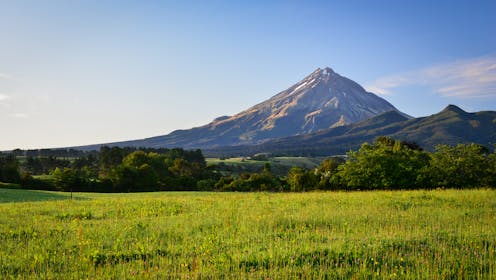Learning to live with the 'messy, complicated history' of how Aotearoa New Zealand was colonised
- Written by Richard Shaw, Professor of Politics, Massey University

Not I, some child born in a marvellous year / Will learn the trick of standing upright here.
The final couplet in Alan Curnow’s poem “The Skeleton of the Great Moa in the Canterbury Museum, Christchurch” can be read in many ways. One is to see in it a gloomy acceptance of the impossibility of finding one’s place in another people’s land. Another is to find in Curnow’s words a bolshy refusal to even attempt the act at all.
But to remain resolutely non-upright, it seems to me, would require the awkward meshing of memories of some other land in which (once upon an earlier time) one did stand upright, with a sort of historical amnesia regarding the place in which it now seems so difficult to find one’s feet.
Here are some things about the land on which my people established themselves in Aotearoa that were, for a long time, forgotten.
My great-grandfather, Andrew Gilhooly, was one of the 644 members of the Armed Constabulary (AC) that invaded Parihaka[1] on the morning of November 5 1881. He was there for the weeks and months that followed, during which women were raped, whare[2] were torn down, crops destroyed and people’s possessions and treasures looted.
Parihaka is not just an invasion day story, and Andrew remained at Parihaka as part of an occupying force until the end of 1884. The occupation was not benign. On April 17 1882, for instance, the AC broke up an attempt by non-Parihaka Māori to distribute food at the pā. The parliamentary record has Native Minister John Bryce finding the idea of Māori taking supplies to Parihaka to be “in every way objectionable”.
Read more: From Parihaka to He Puapua: it’s time Pākehā New Zealanders faced their personal connections to the past[3]
And so, in retaliation for “this act of antagonism to the expressed orders of the Government” – in other words, to punish people whose gardens have been destroyed and whose stock have been stolen for having had the temerity to try to feed themselves – the AC pulled down a dozen more whare.
Andrew returned to the coast a decade or so after he left, this time to become a farmer. He and his wife Kate would eventually control three family farms. All were within a couple of kilometres of Parihaka and each part of the 1,275,000 acres of land confiscated from mana whenua[4] by the colonial government under the provisions of the New Zealand Settlements Act[5] and then granted to soldiers or sold to people like my great-grandparents.
Punishment for ‘sedition’
Andrew obtained title to the first farm – section 44, Block 12 of the Cape Survey District (CSD) – in 1895. It was on the seaward side of the South Road (he had participated in its construction when he was with the AC) and was therefore available for freehold purchase.
Had the road been further to the west, as originally surveyed, he might not have been able to buy the property, because it would have been part of the land on the mountain side of the road that was initially set aside for Māori reserves. But a surveying error meant the South Road wound up being closer to Taranaki maunga than it should have been, freeing up 5,000 additional acres for freehold sale – including section 44.
Read more: Separatist or radically inclusive? What NZ’s He Puapua report really says about the Declaration on the Rights of Indigenous Peoples[6]
My great-grandmother, Kate, purchased the third of the Gilhooly farms in 1921. Section 102, Block 12 of the CSD, which the Native Land Court named “Parihaka A”, was on the mountain side of the road but was not leasehold land. It did, however, contain an urupā[7]. No-one seems to know whose people lay in it, or whether or not it still exists.
Furthermore, Parihaka A was part of the 5,000 acres of land the colonial government decided, in 1882, to hold back from any future Māori reserves as “an indemnity for the loss sustained by the government in suppressing the Parihaka sedition”.
The sedition, to be clear, that was non-violent and whose protagonists welcomed my great-grandfather and his AC comrades into the pā with gifts of food. (And for a time the food kept coming: on New Year’s Day 1882, mere weeks after their pā had been destroyed, the people of Parihaka prepared a hangi for members of the occupying force.)
But it is the second farm that I want to talk about here, because that was on Māori leasehold land.
Locked out of their own land
The history of the West Coast leasehold system[9] is, I suspect, even less well understood than that of the invasion and plunder of Parihaka. Briefly, in 1882 the government began restoring to Māori some of the land it had confiscated 20 years earlier.

















